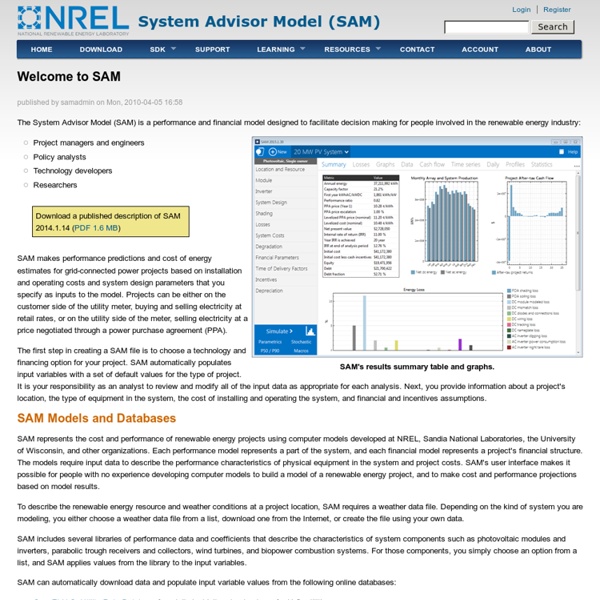



PNNL: FEDS - Facility Energy Decision System The Facility Energy Decision System (FEDS) is an easy-to-use building energy efficiency software tool that quickly and objectively identifies energy efficiency improvements that maximize life-cycle savings. The Windows-based program requires only minimal user experience and input to perform energy efficiency assessment screenings as well as detailed energy retrofit project analyses across a wide variety of building types, from single buildings to large multi-building campuses and installations. Requires only minimal user input yet is able to accept detailed building system parameters. FEDS estimates unspecified parameters based on typical characteristics for a building of the specified type, size, age, and location and other details. Models energy and cost performance of heating, cooling, ventilation, lighting, motors, plug loads, refrigeration, building shell, and hot water systems, plus central plants and thermal loops.
Opensource-solar.org | DIY photovoltaics for all PVWatts Calculator The latest minor release in October 2016 changed our source for India rupee exchange rates and a few bug fixes. PVWatts® was updated on July 2016. Capacity Factor has been added to the displayed results page and both the monthly and hourly downloads. Our previous release as in April and it removed available incentives from the app. Our source of incentives was found not to be consistent enough to provide an accurate reflection of costs. We are often asked about the annual variation in what the system will produce and how different the actual results will be. We analyzed 30 years of historical solar irradiance and weather patterns for 239 locations in the US. The calculated results from PVWatts® are an estimate of what you might actually experience, and are based on assumptions, uncertainties, and incomplete information about your particular PV system and location. PVWatts® was updated on May 5th, 2016. Please click on the “Feedback” button below to provide feedback to us.
Hydrogen Analysis Resource Center Free Interactive Design Tools for Solar Power Energy Systems PVWatts Calculator Green Lab Challenge | Argonne's Sustainability Initiative Taking 10 minutes to inspect your home for water leaks can lead to big financial savings. By Peter Lynch, Environmental Engineer The U.S. To give you a sense of how much you could be saving, it’s estimated that a leaking faucet can waste about 3,000 gallons of water per year, a dripping showerhead about 500 gallons per year and a running toilet about 200 gallons of water per day. The EPA provides a set of online tools to help homeowners identify common water leaks, as well as what they can do to fix the problems. The EPA’s WaterSense website also includes helpful tips on how to be more water efficient, including a calculator to help determine how much water and money can be saved by replacing old plumbing fixtures. Here are five easy tips to help reduce your monthly water bill: Some environmental benefits of saving water: Your everyday actions can make an impact, so make conscious decisions on how you use water.
National Laboratories: Tutorial on PV System Modeling Modeling PV system performance involves a number of steps that are shown in the figure below. A more detailed explanation of each step is presented below the figure. Irradiance and Weather – This step involves choosing a source for defining the site’s expected irradiance and weather conditions. ZPV Argonne TTRDC - TransForum v10n1 - How Green is Your Grid The carbon impact of the millions of electric vehicles that may soon hit the road will depend on the electric grids that supply them. The odds are that your batteries won’t be recharged with solar or wind energy. In most places, grid power will come from the burning of fossil fuels, which generate their own emissions. So the question really is: “If you power a vehicle with electricity from the grid rather than with fuel from the tank, is that better or worse for the environment, particularly with respect to greenhouse gases like carbon dioxide?” How do you compare a PHEV (plug-in hybrid electric vehicle) that can recharge from wall current against a conventional gasoline car that consumes, say, 9.4 liters per 100 kilometers (25 miles per gallon)? In this case, using grid power to drive electrically emits fewer greenhouse gases per kilometer—under any circumstances. March 2010
DSIRE Note: In April 2014 H.B. 2101 substantially modified Kansas’s net metering and interconnection rules, creating different rules for renewable energy systems beginning operation on or after July 1, 2014. Kansas adopted the Net Metering and Easy Connection Act in May 2009, which established net metering for customers of investor-owned utilities (IOUs). Eligibility and Availability All IOUs in Kansas—Westar, Kansas City Power & Light, and the Empire Power District—are required to offer net metering, and some electric cooperatives have voluntarily created net metering provisions for their customers. IOUs are required to offer net metering on a first-come, first-served basis until the rated generating capacity of all net-metered systems equals 1% of the utility's peak demand during the previous year. Net metering applies to systems that generate electricity using solar, wind, methane, biomass, or hydro resources, and to fuel cells using hydrogen produced by an eligible renewable technology.